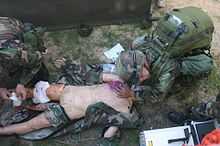Moulage

Moulage (French: casting/moulding) is the art of applying mock injuries for the purpose of training Emergency Response Teams and other medical and military personnel. Moulage may be as simple as applying pre-made rubber or latex "wounds" to a healthy "patient's" limbs, chest, head, etc., or as complex as using makeup and theatre techniques to provide elements of realism (such as blood, vomitus, open fractures, etc.) to the training simulation. The practice dates to at least the Renaissance, when wax figures were used for this purpose.
In Germany some universities and hospitals use their historical moulage collections for the training of students. The often very lifelike models are especially useful to show the students today the characteristics of rare diseases, such as Skin tuberculosis or leprosy.[1]

History of Medical Moulage
The history of wax models is ancient. Wax anatomical models were first made by Gaetano Giulio Zummo (1656–1701) who first worked in Naples, then Florence, and finally Paris, where he was granted monopoly right by Louis XIV. Later, Jules Baretta (1834–1923) made more than 2000 splendid wax models in Hospital Saint-Louis, Paris, where more than 4000 wax models were collected. While wax models were being made, he made pleasant conversations with the patients, sang songs or at times played the piano. Moulages were made for the education of dermatologists around the world, but were eventually replaced by color slides.
In the 19th century moulage was taken of medical patients for educational purposes. The prepared model was painted to mimic the original disease.
References
See also
- Makeup
- EMS
- Objective Structured Clinical Examinations (OSCE)
- Theatrical blood
External links
| Wikimedia Commons has media related to Moulage. |
- http://www.moulagen.de/sammlungen/ International Overview of moulage collections of the Charité Berlin
- Museum of Moulages, University of Zurich (English/ German)
- Jacobi, Eduard (1913) [1903]. Atlas der Hautkrankheiten [Atlas of Skin Diseases] (in German) (5th ed.). Berlin: Urban & Schwarzenberg. OCLC 250681193.
- "Search Our Collection". Museum of Health Care. Retrieved December 3, 2011.
- Gordon, Ken (December 3, 2011). "OSU clinical instructor crafts simulated injuries, giving nursing students a more realistic look at trauma". The Columbus Dispatch. Retrieved December 3, 2011.